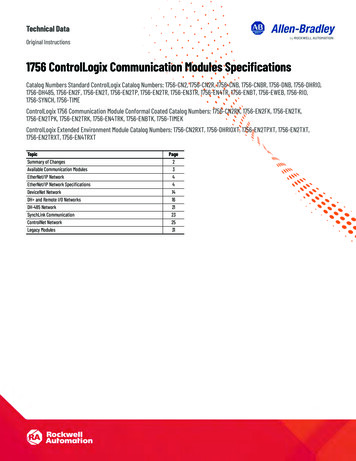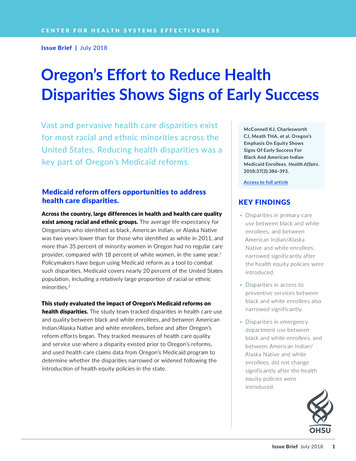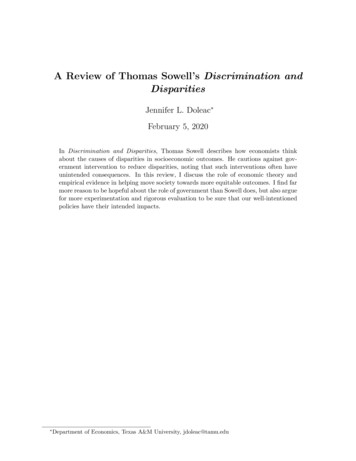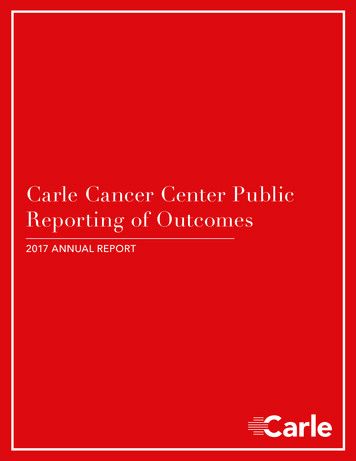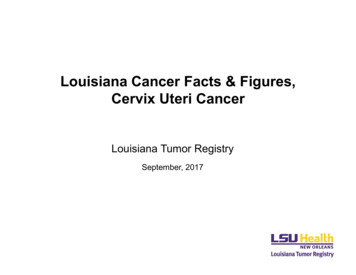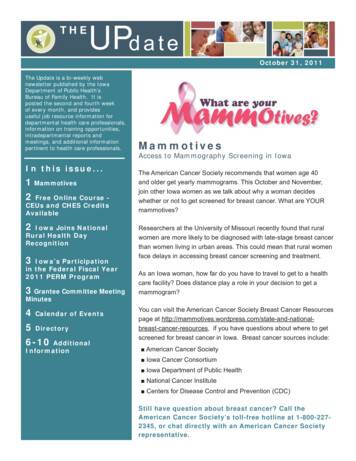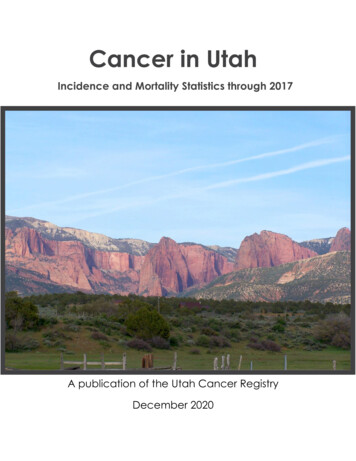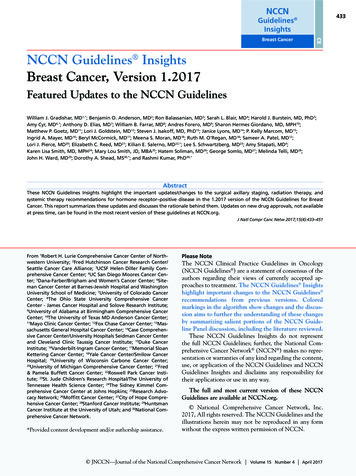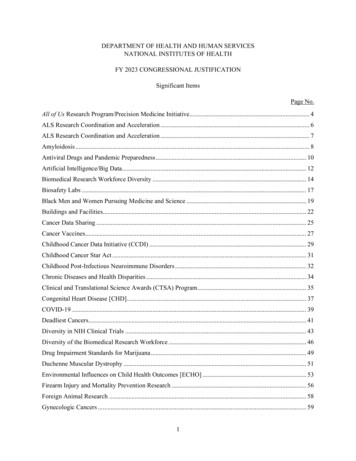
Transcription
DEPARTMENT OF HEALTH AND HUMAN SERVICESNATIONAL INSTITUTES OF HEALTHFY 2023 CONGRESSIONAL JUSTIFICATIONSignificant ItemsPage No.All of Us Research Program/Precision Medicine Initiative. 4ALS Research Coordination and Acceleration . 6ALS Research Coordination and Acceleration . 7Amyloidosis . 8Antiviral Drugs and Pandemic Preparedness . 10Artificial Intelligence/Big Data. 12Biomedical Research Workforce Diversity . 14Biosafety Labs . 17Black Men and Women Pursuing Medicine and Science . 19Buildings and Facilities. 22Cancer Data Sharing . 25Cancer Vaccines. 27Childhood Cancer Data Initiative (CCDI) . 29Childhood Cancer Star Act . 31Childhood Post-Infectious Neuroimmune Disorders . 32Chronic Diseases and Health Disparities . 34Clinical and Translational Science Awards (CTSA) Program . 35Congenital Heart Disease [CHD] . 37COVID-19 . 39Deadliest Cancers. 41Diversity in NIH Clinical Trials . 43Diversity of the Biomedical Research Workforce . 46Drug Impairment Standards for Marijuana . 49Duchenne Muscular Dystrophy . 51Environmental Influences on Child Health Outcomes [ECHO] . 53Firearm Injury and Mortality Prevention Research . 56Foreign Animal Research . 58Gynecologic Cancers . 591
Harassment Policies . 62Hearing Health Screening for Older Americans . 65Hepatitis B . 66Indoor Amplified Microbial Growth Research . 68Interstitial Cystitis . 71Kratom . 72Lung Cancer in Women . 73Lyme Disease and Related Tick-Borne Illnesses . 75Lymphedema (LE) . 77Maternal Health Research . 78Maternal Infections . 80Melanoma . 81Metastatic Breast Cancer . 84Multiple Sulfatase Deficiency. 86National Laboratories. 88National Center on Sleep Disorders Research [NCSDR] . 91National Dental Practice-Based Research Network [NDPBRN] . 93National SARS–CoV–2 Genomic Surveillance Program . 95NIH Division of Police . 97Office of Behavioral and Social Sciences Research (OBSSR) . 98Osteopathic Medical Schools . 100Overactive Bladder and Cognitive Impairment Treatment . 102Pancreatic Cancer. 104Parkinson’s Disease . 106Parkinson’s Disease (PD) . 107Parkinson’s Disease (PD) and Dementia . 109Pediatric Cancer Expertise . 111Pediatric Nephrology Research Awards . 113Pediatric Nephrology Workforce Diversification . 114Pediatric Research . 116Polycystic Kidney Disease . 119Polycystic Ovary Syndrome (PCOS) . 120Pulmonary Fibrosis (PF) . 122Prostate Cancer Disparities . 124Rare Disease Research . 1262
Research on Cancer Disparities . 128Research Transparency . 130SARS–CoV–2 . 131Skin Cancer in Communities of Color . 133Spasmodic Dysphonia. 135Suicide Prevention . 136Surveillance, Epidemiology, and End Results [SEER] Registry . 138Telehealth-Based Services for Vulnerable Patients . 140Tobacco Regulatory Science Program . 142Trans-NIH Pediatric Research Consortium . 144Valley Fever . 1473
All of Us Research Program/Precision Medicine InitiativeThe Committee provides a total of 541,000,000 for the All of Us precision medicine initiative, 41,000,000 above the fiscal year 2021 enacted level and consistent with the fiscal year 2022 budgetrequest. The total includes 150,000,000 authorized in the 21st Century Cures Act (Public Law 114–255)to be transferred from the NIH Innovation Account. The Committee directs NIH to continue its efforts torecruit and retain participants from historically underrepresented populations in biomedical research, andto expand its efforts to enroll participants from geographically diverse communities. To achieve thisdiversity, NIH is encouraged to support additional avenues for enrollment from the Midwest and GreatPlains regions that facilitate participation from both rural and urban communities. These efforts will helpensure that All of Us scientific resources reflect the rich diversity of our country and that advances madefrom this program will benefit the health of all Americans.Action taken or to be takenThe All of Us Research Program’s mission is to accelerate health research and medical breakthroughs toenable individualized prevention, treatment, and care for all of us. All of Us is on its way to enrolling onemillion or more participants, and as of November 2021, more than 434,000 participants had consented tojoin the program and more than 309,000 participants had completed all steps in the initial protocol. Theprogram’s participants continue to reflect the rich diversity of the United States and are from differentraces, ethnicities, age groups, and from all regions in the country Nearly 50 percent of All of Usparticipants who have shared health information and biosamples are from racial and ethnic minoritycommunities, and nearly 80 percent are from communities historically underrepresented in biomedicalresearch – including people living in rural areas, older adults, economically disadvantaged, and sexualand gender minority populations. All of Us remains committed to community engagement for both urbanand rural populations. In 2021, the program funded the next iteration of engagement work, whichincludes adding three additional partners, the American Association of Health and Disability, the NationalBaptist Convention USA, Inc., and Baylor College of Medicine to the program’s robust network ofengagement partners. 1Currently, individuals over the age of 18 who are living anywhere within the United States can join theAll of Us Research Program by enrolling on the program’s website. 2 Once enrolled online, participantscan complete enrollment by donating biosamples through the program’s network of Healthcare ProviderOrganizations (HPO), including Regional Medical Centers, Federally Qualified Healthcare Centers, andalternative enrollment locations, and through the program’s long-term partnership with Veterans AffairsHospitals (VA). The program currently has a network of enrollment locations covering several states inthe Midwest and Great Plains including HPOs located in Colorado, Illinois, Michigan, Minnesota, NorthDakota, and Wisconsin, and additional VA enrollment locations located in Indiana, Iowa, Kansas, andMinnesota. The program also anticipates opening additional VA locations in Colorado. The programcontinues to explore more enrollment options to meet participants where they are, and this includesproviding enrollment opportunities for interested individuals who are not close to an existing enrollmentcenter. Starting in 2021, participants who are unable to join at an existing enrollment center may requesta mailed saliva kit to fulfill the initial sample contribution from anywhere in the United States. As ofNovember 2021, more than 12,000 additional participants donated biosamples through saliva kits. In thefuture, the program aims to offer additional opportunities that allow biosample donation for participantsoutside of an enrollment center. This could include home visits or mailed kits for blood collection atclinical phlebotomy laboratories. Diversity, equity, inclusion, and accessibility are core values within community-partners2allofus.nih.gov/4
All of Us Research Program, and the program will continue to explore additional enrollment methods thatensure the program’s participants reflect the rich diversity of our country and that advances made fromthis program will benefit the health of all Americans.5
ALS Research Coordination and AccelerationThe Committee is aware of the significant need to expand scientific understanding of amyotrophic lateralsclerosis (ALS) and to translate ALS science more rapidly into effective treatments that can make ALS alivable disease. To achieve these outcomes as soon as possible, the Committee directs NIH to organize atrans-agency initiative to develop an ALS research strategic plan. The plan, which should be developed incollaboration with the nation’s leading ALS patient and biomedical research organizations, should:identify the most promising areas of research and the specific NIH activities where additional fundingcould lead to more rapid translation of discoveries for treatments, prevention, and interventions ortechnologies that can reduce the burden of ALS; identify which Institutes and Centers are undertakingALS and ALS-related research and which are not but have a role to play; and uncover any impediments toALS research. As part of this effort, NIH should hold at least one public meeting at which stakeholderscan provide testimony. This effort should include, but not be limited to: NINDS, NIA, NIEHS, NIMH,NHGRI, NIAMS, and NCATS.Action taken or to be takenThe National Institute of Neurological Disorders and Stroke (NINDS) is the lead National Institutes ofHealth (NIH) Institute for amyotrophic lateral sclerosis (ALS) research. NINDS has begunorganizing astrategic planning effort for ALS research. As part of this effort, NINDS will solicit broad input from thepublic via public Requests for Information and a public meeting, and will engage relevant NIH Institutesand Centers, federal agencies, and non-governmental organizations to develop research recommendationsfor advancing research on ALS as described by the Committee.NINDS currently supports a broad, diverse research portfolio on ALS, including investigator-initiatedresearch projects to understand the genetic and environmental causes of ALS and to elucidate the cellularand molecular mechanisms by which the disease progresses. To augment this investigator-initiatedresearch program, NIH established the Accelerating Leading-edge Science in ALS (ALS2) initiative, partof the NIH Common Fund’s Transformative Research Awards, which will dramatically advance ourunderstanding of what triggers ALS and what drives the rapid progression of this disease. NINDS is alsosupporting several large natural history and biomarkers studies that aim to identify biomarkers that predictwhen people at risk for ALS might get the disease, allowing them to begin treatment early, perhaps evenbefore symptoms appear. NINDS supported preclinical research projects are testing a range oftherapeutic targets and agents, including gene therapies and small molecule drugs, in experimental modelsof ALS, including animals or cells/tissues, to treat inherited and sporadic forms of ALS. Finally, severalpromising industry-funded clinical trials are proceeding based upon NIH-supported basic and preclinicalresearch findings.6
ALS Research Coordination and AccelerationAdditionally, The Committee strongly supports the Transformative Research Award program for ALSand directs the Director to continue to fund this critical initiative in fiscal year 2022.Action taken or to be takenThe National Institutes of Health (NIH) Common Fund’s Accelerating Leading-edge Science in ALS(ALS2), part of the Transformative Research Award initiative, aims to stimulate innovative research andanswer critical scientific questions about ALS. Research supported through ALS2 is intended to beexceptionally creative, with the potential to transform research on the molecular causes of ALS, describehow the disease progresses, and develop possible therapeutic strategies. The hope is that ALS2 willintroduce new ideas into the field to rapidly advance progress towards safe and effective therapies. Theseawards also encourage attracting new talent from a range of scientific disciplines, including cell biology,bioengineering, chemistry, biophysics, environmental health sciences, and computational science, as wellas formation of new multi- and interdisciplinary collaborations.The first funding opportunity announcement for ALS2 was issued in June 2020. Applications werereceived by September 2020, and the first round of awards were announced in fall 2021. NIH issued fourTransformative Research awards 3 for the ALS2 initiative in fiscal year 2021. These awards are addressinghow the disease works at the cellular level by identifying the genetic and cellular factors that drive nervecell death; determining how environmental exposures that may contribute to ALS disease risk interactwith molecular and immune features also associated with ALS; investigating the restoration of thebalance among key proteins that impact ALS as a treatment option; and determining how changesassociated with the disease are linked to dysfunction in specific cell types in ALS. These awardsrepresent a 5-year, 25 million investment by the NIH. This initiative is managed collaboratively by theCommon Fund, the National Institute of Neurological Disorders and Stroke, the National Institute onAging, the National Institute of Environmental Health Sciences, and the National Institute of GeneralMedical Sciences.3commonfund.nih.gov/TRA/recipients7
AmyloidosisThe Committee directs NIH to continue its expansion of research efforts in amyloidosis, a group of rarediseases characterized by abnormally folded protein deposits in tissues. Amyloidosis is often fatal, andthere is no known cure. Current methods of treatment are risky and unsuitable for many patients. Averagesurvival without treatment is in months. The Committee directs NIH to provide an update in the fiscalyear 2023 Congressional Budget Justification on the steps NIH has taken to expand research into thecauses of amyloidosis and the measures taken to improve the diagnosis and treatment of this devastatinggroup of diseases.Action taken or to be takenAmyloidosis is a group of diseases in which an abnormal protein called amyloid builds up in the heart,kidneys, liver, or digestive organs. This buildup often leads to compromised organ function. For example,researchers supported by the National Institute on Aging (NIA) have identified cardiac amyloidosis as arisk factor for heart failure with preserved ejection fraction, a condition in which the heart’s left ventricleis unable to fill properly, resulting in an insufficient supply of blood pumping throughout the body.Although amyloidosis remains largely incurable, advances in treatment have extended lifespan in manycases and improved quality of life for individuals with the condition. For example, in a recent phase IIIclinical trial, the drug tafamidis reduced all-cause mortality and improved quality of life in patients withtransthyretin cardiac amyloidosis, a common form of the disease. Much of the basic, preclinical, and earlyclinical research leading up to this industry-funded trial received National Institutes of Health (NIH)support, and the investigator who led this work was recently awarded the Breakthrough Prize—one of theworld’s largest science prizes—for his efforts. NIH also supported a subsequent study demonstrating thattafamidis is equally effective against hereditary and sporadic forms of the disease.Basic research on amyloid and amyloidosis is supported across the NIH. For example, investigatorssupported by the NIA and the National Institute of Diabetes and Digestive and Kidney Diseases (NIDDK)are working to determine why and how misfolded proteins clump together to cause disease. Otherresearch from NIDDK and the National Institute of General Medical Sciences (NIGMS) has clarified theunique biochemical properties of various familial forms of transthyretin amyloidosis that lead to theirbecoming amyloidogenic, discoveries that could ultimately lead to better treatment or prevention of thisdisease. 4Early and accurate diagnosis of amyloidosis remains an active area of study. For example, NIA-supportedinvestigators have developed a highly accurate diagnostic and screening tool for cardiac amyloidosis.Elsewhere, investigators supported by the National Heart, Lung, and Blood Institute (NHLBI) are usingartificial intelligence approaches with digital echocardiographic images to create a completely automatedmethod for diagnosing and tracking rare heart diseases, including cardiac amyloidosis. NHLBI alsosupports research investigating whether genetic risk factors can be used to guide radiologic imaging ofcardiac amyloidosis, especially among older African American and Hispanic/Latino patients, in whomamyloidosis may be underdiagnosed.NIH supports clinical treatment trials using a range of drugs, including small molecule inhibitors,monoclonal antibodies, biological therapies, and agents commonly used in cancer chemotherapy. RecentNIDDK- and NIA-funded research has identified a promising potential strategy for treating light chain(LC) amyloidosis, the most common systemic amyloid disease, typically occurring when amyloidogenic4pubmed.ncbi.nlm.nih.gov/33645214/8
antibody LCs are secreted by certain types of abnormal blood cells. 5 The compound reduced secretion ofthe LC amyloid precursors and was found to be effective in cells isolated from LC amyloidosis patientsand to be non-toxic to mice.To advance drug development for these diseases, the Amyloidosis Forum was created through apublic/private partnership between the Amyloidosis Research Consortium and the U.S. Food and DrugAdministration (FDA) to discuss the challenges, address the obstacles, and find pathways towardsaccelerating drug development in light chain amyloidosis. The most recent meeting was held October2020 with NIA support, and focused on natural history and endpoint development.5pubmed.ncbi.nlm.nih.gov/33599742/9
Antiviral Drugs and Pandemic PreparednessThe Committee strongly encourages NIAID efforts to establish a public-private partnership focused onglobal pandemic preparedness and antiviral drug discovery, in coordination with BARDA. Such apartnership could leverage the best of academia and pharmaceutical manufacturers to develop broadspectrum antiviral drugs to address rapidly emerging public health threats, helping our nation be betterprepared for the next global pandemic. The Committee directs NIAID to provide an update on this andany related efforts in the fiscal year 2023 Congressional Budget Justification.Action taken or to be takenThe National Institute of Allergy and Infectious Diseases (NIAID) supports research to better understand,treat, and prevent infectious diseases as well as to respond to emerging public health threats. NIAID andthe National Center for Advancing Translational Sciences (NCATS), in collaboration with the BiomedicalAdvanced Research and Development Authority (BARDA), have initiated the Antiviral Program forPandemics (APP), which supports the development of broad-spectrum antiviral drugs to address rapidlyemerging public health threats through public-private partnerships. The APP will develop antivirals tocombat severe acute respiratory syndrome coronavirus 2 (SARS-CoV-2), build sustainable platforms fordrug discovery, and develop a pipeline of antivirals against select viruses with pandemic potential. TheAPP will focus on accelerating development of direct-acting antivirals—particularly against RNA virusesof pandemic potential such as SARS-CoV-2—from discovery to early development. Of particular interestare oral or intranasal antiviral candidates that could be taken at home early in the course of infection.These antivirals could prevent transmission of the virus and help to stem overwhelming surges inhospitalizations resulting from viral infections.Through the APP, NIAID will utilize existing research resources and preclinical services, which include afull suite of early-stage drug development activities, and provides in-kind support for the development ofpromising antiviral candidates. NIAID will also continue to support basic research that will feed into thedevelopment pipeline for antiviral candidates.As part of the APP drug discovery effort, NIAID released a funding opportunity announcement toestablish Antiviral Drug Discovery (AViDD) Centers for Pathogens of Pandemic Concern in FY 2022. 6AViDD will be comprised of multidisciplinary centers focused on discovering and developing newantiviral candidates targeting SARS-CoV-2 and other viruses with pandemic potential.NIAID also plans to utilize public-private partnerships and award product development contracts tosupport the development of promising antiviral candidates from late-stage preclinical studies throughclinical testing. These efforts will help advance candidate antivirals into clinical trials and facilitate latestage development by industry or BARDA. BARDA will support the manufacturing of drug candidatesfor clinical trials and the development of analytical assays needed for drug substance and drug productrelease.In addition, NCATS will be a key partner in APP alongside NIAID and BARDA to accelerate antiviraldrug development through early discovery and preclinical development. NCATS will coordinate withpotential partners to develop candidates and take them into clinical development with APPpartners. NCATS will apply its proficiency in drug discovery and development and its cutting-edgetechnologies, such as high-throughput screening, Artificial Intelligence/Machine Learning/DeepLearning, and advanced biological testing (including tissue models of infection), to drive preclinical 21-050.html10
discovery that will fill critical needs of the APP. NCATS’ expertise in preclinical development willcomplement the mechanisms for supporting drug development at NIAID and BARDA.NIAID will continue to coordinate with NCATS and BARDA on the APP to help prepare for and respondto existing and newly emerging infectious disease threats.11
Artificial Intelligence/Big DataNIH continues to expand its efforts to develop its capacity to leverage the potential of machine learning[ML] to accelerate the pace of biomedical innovation. The Office of Data Science Strategy [ODSS],collaborating with NLM, has been working to ensure new research datasets meet the international FastHealthcare Interoperability Resources [FHIR] standard requirements and provide opportunities for dataexperts to work in the field of biomedicine. It is also developing a governance structure for the rapidlydevelop fi
Organizations (HPO), including Regional Medical Centers, Federally Qualified Healthcare Centers, and alternative enrollment locations, and through the program's long-term partnership with Veterans Affairs Hospitals (VA). The program currently has a network of enrollment locations covering several states in
